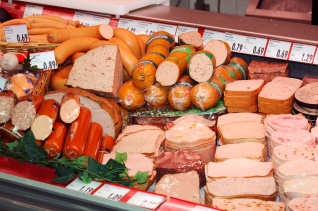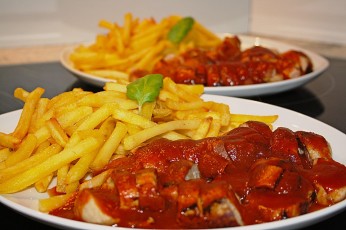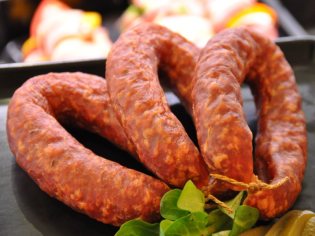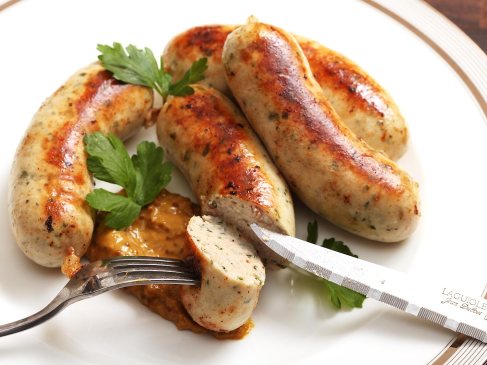Disclaimer: Before I begin this post, let me apologize in advance for the title referencing Meghan Trainor’s tasteless song.
If Germans have a staple diet, it is not Schnitzel or potatoes (although they do come close), it is the Wurst. From time to time Germans feel a calling from deep within themselves; they say naturalized citizens even claim hearing voices in their heads. The calls and voices lead people to the nearest Wurst stands where they binge on the tubular steaks and leave with a silly smile on their faces and a noticeable tightening of their bellies.
Statistically, Germany is one of the wurst (see what I just did there?) countries to be a livestock animal. Germans consume an epic 60 kg of meat per person per year. The global average is 42 kg. Yeah, these folks eat a lot of meat. So much in fact that Germany has a whopping 1500 different kinds of sausages! In this post, I’ll try to skim the surface of the German art form that is the Wurst.
Sausage making is present in Germany since centuries. Before the invention of refrigeration, sausages were a good way to preserve meat and eat it later. But it isn’t just about preserving meat. Many regions in what is now Germany sought to distinguish themselves through their sausages which became their pride and joy. Famous examples of such wurst are the Frankfurter, Nürnberger and the Münchner Weisswurst. While wurst are primarily made from pork, there are many varieties with beef and even chicken and turkey available in the country today. There are even tofu version for those of the vegetarian persuasion.
Wurst are as different as can be from Pakistani food, so I had to do some digging and researching for this post. In Pakistan we mostly have one kind of sausage which people erroneously refer to as a “hot dog” in reference to the American fast food. Sausages in Germany can be broadly classified into Brühwurst (boiled sausage), Kochwurst (cooked sausage) and Rohwurst (raw sausage). Keep in mind that this is a really broad classification. Entire books have been written on the subject.
The Brühwurst is the most commonly available wurst in Germany; being readily available at fast food stands. Perhaps the most known form of the Brühwurst for both Germans and foreigners is the Currywurst. Germans go nuts over this snack and rightly so. Although there is a tussle between Berlin and the Ruhr Area about who actually invented the Currywurst, there is a consensus that whoever did it did humanity a great service and deserves a medal. Since I live in NRW, I will go ahead and shamelessly endorse Dönninghaus in Bochum as the go-to place for the best Currywurst in the Western Hemisphere. Famous Brühwürste include the world renowned Wiener*. The Wiener is also the “hot dog” we Pakistanis refer to. Although the original Wiener is made out of pork, it is readily available in other meat as well as tofu varieties.
The Kochwurst is pre-cooked sausage usually eaten cold. The Kochwürste are usually composed of very specific parts of the an animal – usually a cow or a pig. The famous blood sausage (Blutwurst) is a type of Kochwurst as is the Leberwurst. It is essentially cooked meat or internal organs, pressed together as a sausage. While I am quite experimental with German food, this is something I am never going to try out. It’s just a wee bit weird for me.
This brings us to the Rohwurst category. This is uncooked meat eaten either as is or cooked together with other food. To make it clear to you, salami is Rotwurst, although it isn’t German. It is, however, eaten a lot in Germany, mostly on pizza. German examples of Rohwurst are Mettwurst and Teewurst. For those following my blog, you may remember that Mett is on my list of German food I am not willing to try.
At this point you might be thinking, why has this guy even written this post when he obviously doesn’t like German wurst? Well friends, it is time for the best of the wurst**. Enter, the Bratwurst. I am told the words mind blowing, ohmygodwherewasthisallmylife and woah were uttered by me one after the other when tasting this German invention. The tale of the Bratwurst – the life of German summer barbecues – begins in 1313 in the city of Nuremberg in Bavaria. It is said*** that a peasant once threw a sausage by mistake on a grill. A member of the royalty was passing by on this occasion, saw the potential of this act of accidental genius and decided to make it a sensation. The rest is history.
Bratwurst is grilled sausage which is delicious and is usually served with bread rolls (Brötchen) and various condiments. Although there are many varieties of it, the Nürnberger Bratwurst from Nuremberg and the Thüringer Bratwurst from the state of Thuringia are the most popular ones. Besides being a must-have on barbecues, it is also served at fairs, public gatherings and Christmas Markets. You gotta try this if you haven’t yet. Sadly, the non-pork or vegetable varieties aren’t so easy to find. Because I don’t eat pork, that is something which is quite irritating to me. Just hope someone exploits this hole in the market soon. They’ll have one dedicated consumer for sure.
Coming from Pakistan, I had only seen brown sausages before coming to Germany. What other color could sausages be, right? So I was quite surprised when the Weisswurst (white sausage) hit the supermarket shelves during the summer. Also a staple of the German summer barbecue season, and hailing from Bavaria as well, the Weisswurst is quite yummy and I buy it almost every time I see it in the winter in the supermarket. The first time I tried it, it was love at first bite and my girlfriend has learned to live with the fact that it will always be my first love.
Well, that’s all from the sausage front, folks. Hope you had a good time reading this post and will try some German wurst ASAP. If you’re an expat and new to Germany, I encourage you to delve into the world of German sausages and to not be a Das ist mir wurst kind of person. By the by, that last bit is a German sausage idiom. How cool is that?!
*Named as a tribute to the city of Vienna, but not after it.
**Got a lot more of these one liners up my sleeve.
***Only by me.







Yum, yum, yum! I’m a huge fan of the Wurst 🙂 Though I think I’m with you on not trying the raw ones! I am NOT a fan of Leberkase either!!
LikeLiked by 1 person
For me, eating anything cold which isn’t dessert is weird because in Pakistani cuisine, all non-dessert food is always cooked and served warm. But I have become accustomed to eating deli meat from time to time. It’s a deli-cacy for me (see what I just did there? 😀 ).
LikeLike